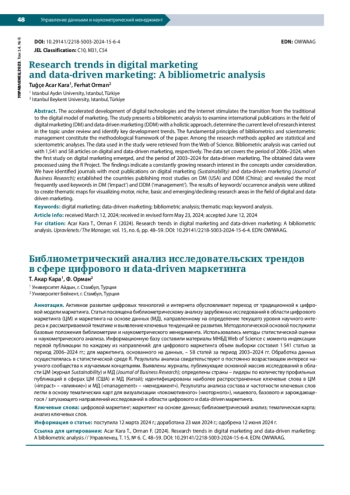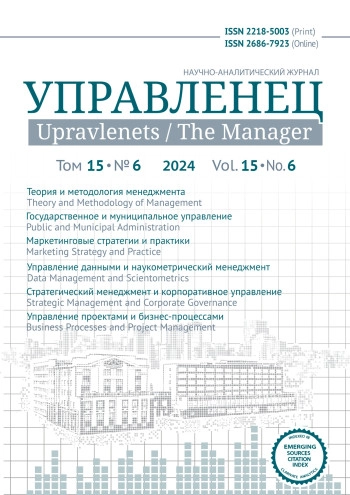1 Amiri A.M., Kushwaha B.P., Singh R. (2023). Visualisation of global research trends and future research directions of digital marketing in small and medium enterprises using bibliometric analysis. Journal of Small Business and Enterprise Development, vol. 30, no. 3, pp. 621–641. https://doi.org/10.1108/jsbed-04-2022-0206 Andrejevic M. (2002). The work of being watched: Interactive media and the exploitation of self-disclosure. Critical Studies in Media Communication, vol. 19, no. 2, pp. 230–248. https://doi.org/10.1515/9781474473231-086
2 Aria M., Cuccurullo C. (2017). Bibliometrix: An R-tool for comprehensive science mapping analysis. Journal of Informetrics, vol. 11, no. 4, pp. 959–975. https://doi.org/10.1016/j.joi.2017.08.007 Bernoff J. (2011). Competitive strategy in the age of the customer. Cambridge, MA: Forrester Research. Braverman S. (2015). Global review of data-driven marketing and advertising. Journal of Direct, Data and Digital Marketing Practise, vol. 16, pp. 181–183. https://doi.org/10.1057/dddmp.2015.7
3 Buehler H., Horvath B., Lyons T., Arribas I.P., Wood B. (2020). A data-driven market simulator for small data environments. SSRN. https://doi.org/10.48550/arXiv.2006.14498
4 Bulunmaz B. (2016). Evolution in marketing methods with developing technology and digital marketing. TRTakademi, vol. 1, no. 2, pp. 350–364. (in Turkish)
5 Cobo M. (2011). An approach for detecting, quantifying, and visualizing the evolution of a research field: A practical application to the Fuzzy Sets theory field. Journal of Informetrics, vol. 5, no. 1, pp. 146–166. https://doi.org/10.1016/j.joi.2010.10.002
6 Cohen J.E. (2013). What is privacy for? Harvard Law Review, vol. 126, no. 7, pp. 1904–1933. Cooperstein D.M. (2013). Competitive strategy in the age of the customer. Cambridge, MA: Forrester Research.
7 Daim U.T., Rueda G., Martin H., Gerdsri P. (2006). Forecasting emerging technologies: Use of bibliometrics and patent analysis. Technological Forecasting and Social Change, vol. 73, no. 8, pp. 981–1012. https://doi.org/10.1016/j.techfore.2006.04.004
8 Dunakhe K., Panse C. (2022). Impact of digital marketing – a bibliometric review. International Journal of Innovation Science, vol. 14, no. 3/4, pp. 506–518. https://doi.org/10.1108/ijis-11-2020-0263
9 Durieux V., Gevenois P.A. (2010). Bibliometric indicators: Quality measurements of scientific publication. Radiology Society of North America, vol. 255, no. 2, pp. 342–351. https://doi.org/10.1148/radiol.09090626
10 Ellegaard O., Wallın J.A. (2015). The bibliometric analysis of scholarly production: How great is the impact? Scientometrics, vol. 105, no. 3, pp. 1809–1831. https://doi.org/10.1007/s11192-015-1645-z.
11 Ertuğrul İ., Deniz G. (2018). 4.0 World: Marketing 4.0 and Industry 4.0. BEÜ SBE Dergisi / Bitlis Eren University Journal of Social Sciences, vol. 7, no. 1, pp. 158–170. (in Tirkish)
12 Faruk M., Rahman M., Hasan S. (2021). How digital marketing evolved over time: A bibliometric analysis on Scopus database. Heliyon, e08603. https://doi.org/10.1016/j.heliyon.2021.e08603
13 Gandy O.H. (1993a). The panoptic sort: A political economy of personal information. Boulder, CO: Westview Press.
14 Gandy O.H. (1993b). Toward a political economy of personal information. Critical Studies in Mass Communication, vol. 10, no. 1, pp. 70–97. https://doi.org/10.1080/15295039309366849
15 Garfield E. (1980). Bradford’s law and related statistical patterns. Essays of an Information Scientist, vol. 4, pp. 476–483.
16 Herubel J.P. (1999). Historical bibliometrics: Its purpose and significance to the history of disciplines. Libraries & Cultures, vol. 34, no. 4, pp. 380–388.
17 Hulme E.W. (1923). Statistical bibliography in relation to the growth of modern civilization: Two lectures delivered in the University of Cambridge. Nature, vol. 112, no. 2816, pp. 585–586. https://doi.org/10.2307/2548151
18 Kargaran S., Shahri M., Ghorbani Z., Saberi A., Jamali S., Aleebrahim N. (2022). Trends and patterns in digital marketing research: Bibliometric analysis. Journal of Marketing Analysis, vol. 10, pp. 158 172. https://doi.org/10.1057/s41270-021-00116-9
19 Kim J., Kang S., Lee K.H. (2019). Evolution of digital marketing communication: Bibliometric analysis and network visualization from key articles. Journal of Business Research, vol. 130, pp. 552–563. https://doi.org/10.1016/j.jbusres.2019.09.043
20 Kotler P., Kartajaya H., Setiawan I. (2010). Welcome to Marketing 3.0. New Jersey: John Wiley & Sons, Inc.
21 Kotler P., Kartajaya H., Setiawan I. (2017). Marketing 4.0: Moving from Traditional to Digital. New Jersey: John Wiley & Sons, Inc.
22 Krishen S.A., Dwivedi, K.Y., Bindu N., Kumar S.K., (2021). A broad overview of interactive digital marketing: A bibliometric network analysis. Journal of Business Research, vol. 131, pp. 183–195. https://doi.org/10.1016/j.jbusres.2021.03.061
23 León-Castro M., Rodríguez-Insuasti H., Montalván-Burbano N., Victor J.A. (2021). Bibliometrics and science mapping of digital marketing. Marketing and Smart Technologies (pp. 95–107). Springer, Singapore. https://doi.org/10.1007/978-981-33-4183-8_9
24 Nadler A., McGuigan L. (2017). An impulse to exploit: The behavioral turn in data-driven marketing. Critical Studies in Media Communication, vol. 35, no. 4, pp. 1–16. https://doi.org/10.1080/15295036.2017.1387279
25 Naldi S., Maulina E., Herawaty T. (2022). Digital marketing at SMEs by bibliometric analysis. IJEBD (International Journal of Entrepreneurship and Business Development), vol. 5, no. 4, pp. 682–698. https://doi.org/10.29138/ijebd.v5i4.1895
26 Purnomo A., Asitah N., Firdausi N., Putra W.S., Raya F.K.M. (2021). A study of digital marketing research using bibliometric analysis. International Conference on Information Management and Technology (ICIMTech) (pp. 807–812). Jakarta, Indonesia.
27 Raisig L.M. (1962). Statistical bibliography in the health sciences. Bulletin of the Medical Library Association, vol. 50, no. 3, pp. 450–461.
28 Rosario T.A., Dias D.J. (2023). How has data-driven marketing evolved: Challenges and opportunities with emerging technologies. International Journal of Information Management Data Insights, vol. 3, no. 2, 100203. https://doi.org/10.1016/j. jjimei.2023.100203
29 Saheb T., Amini B., Kiaei Alamdari F. (2021). Quantitative analysis of the development of digital marketing field: Bibliometric analysis and network mapping. International Journal of Information Management Data Insights, vol. 1, no. 2, 100018. https://doi.org/10.1016/j.jjimei.2021.100018
30 Turow J. (2011). The daily you: How the new advertising industry is defining your identity and your worth. New Haven, CT: Yale University Press. Vogt W.P. (1982). Identifying scholarly and intellectual communities: A note on French philosophy, 1900–1939. History and Theory, vol. 21, pp. 267–278. https://doi.org/10.2307/2505248
31 Yu D., Shi S. (2015). Researching the development of Atanassov intuitionistic fuzzy set: Using a citation network analysis. Applied Soft Computing, vol. 32, pp. 189–198. https://doi.org/10.1016/j.asoc.2015.03.027
32 Zhang J., Yu Q., Zheng F., Long C., Lu Z., Duan Z. (2015). Comparing keywords plus of WOS and author keywords: A case study of patient adherence research. Journal of the Association for Information Science and Technology, vol. 67, no. 4, pp. 967–972. https://doi.org/10.1002/asi.23437







